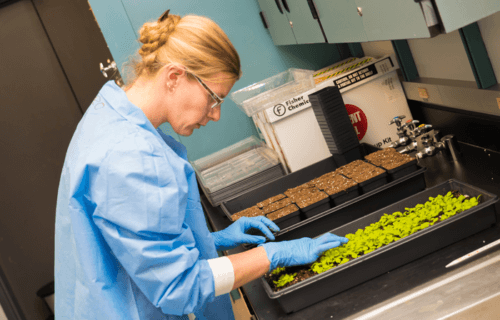SAN DIEGO, Calif. — Not all viruses are bad, and one in particular may have the power to stop cancer. Researchers at the University of California-San Diego are studying how a plant virus called cowpea mosaic virus stops cancer and prevents it from coming back. Their latest research shows that when the virus infects cancerous cells, it signals to the immune system and extends the anti-cancer response toward the tumor.
Cowpea mosaic virus is an infectious plant virus that commonly targets legumes. For the past seven years, however, study authors have been using animal models to determine its potential as a cancer immunotherapy treatment.
“This study helps validate the cowpea mosaic plant virus nanoparticle as our lead cancer immunotherapy candidate,” Nicole Steinmetz, a professor of nanoengineering at the UC San Diego Jacobs School of Engineering and the director of the Center for NanoImmunoEngineering, in a university release. “Now we have mechanistic data to explain why it is the most potent candidate, which further de-risks it for clinical translation.”
The perfect bait for fighting cancer?
The team has studied the cowpea mosaic virus in the form of nanoparticles. They injected the nanoparticles directly into the tumor to serve as bait for the immune system. Once the lure is set, immune cells detect the viral nanoparticles and send alarms to the rest of the immune system of a foreign invader in the body. While the immune cells build up to fight the virus, they start to eliminate the cancerous cells once they realize cowpea mosaic virus is inside a tumor.
Not only does the virus help get rid of the existing tumor, but Dr. Steinmetz notes that it also triggers a systemic immune response against any future tumors. While not studied in humans yet, they have observed this immune effect in canines and mouse models of various types of cancer. The cowpea mosaic virus is also unique in that it triggers an anti-cancer response that scientists don’t see in other plant viruses or virus-like particles.
“We’ve shown that it works, and now we need to show what makes it so special that it can induce this kind of response,” says lead author Veronique Beiss, a former postdoctoral researcher in Dr. Steinmetz’s lab. “That’s the knowledge gap we’re looking to fill.”
The virus triggers more disease-killing inflammation
To look at anti-tumor efficacy in similar plant viruses, the team compared the cowpea mosaic viruses with two plant viruses from the same family with similar shapes and sizes. The cowpea severe mosaic virus shared a similar RNA sequence and protein makeup. The other plant virus, the tobacco ringspot virus, only had a similar structure.
They then infected a melanoma tumor in mice with three doses of each virus-based nanoparticle immunotherapy given a week apart. Mice receiving the cowpea mosaic virus nanoparticles were more likely to survive and have the smallest tumors than those that did not. The tumor growth stopped about four days after the second dose.
Afterward, the researchers took immune cells from the spleen and lymph nodes from mice. They found that all plant viruses contain a protein shell to activate toll-like receptors that are on the surface of immune cells. However, the cowpea mosaic virus takes an extra step by using its RNA to activate an extra toll-like receptor. Activating additional toll-like receptors leads to more pro-inflammatory proteins called cytokines appearing and strengthening the immune response against cancer.
Another way the cowpea mosaic virus increases the immune response is by extending the cytokine response.
“We don’t see this with the other two plant viruses. The cytokine levels peak quickly, then go down and are gone,” explains Beiss. “This prolonged immune response is another key difference that sets cowpea mosaic virus apart.”
The study is published in the journal Molecular Pharmaceutics.


Seriously flawed headline. THERE WILL NEVER BE ONE CURE FOR ALL CANCERS. “Cancer” is a collection of over 300 different diseases
The CDC will kill it. They are about control,not cure.
Bob,
You must be fun at parties.
Gee, Bummer Bob, way to suck all the hope outta the article.
Bob’s right; the definition of cancer is broad and includes different biologies. Additionally, the article says nothing of the cowpea..virus’ effect on normal tissue.
Too bad the entire scientific community is suspect now, since the scamdemic truth has been exposed. Information war. There are cancer cures, that have been hidden from the public for decades. I do my own research now.
Well, isn’t this article interesting.
Remember the old saying, “It is bad business to cure patients.”
Just think how much money the medical, labs & pharmaceutical establishment would lose if we were to be healed and didn’t need anymore medical attention.
Multiple of BILLIONS of dollars!
Viruses from nature unnaturally introduced into the human biology to make us sick from the “trusted” medical corporation is their way of keeping us reliant upon their “services.”
As in a protein sheath put around the virus to trick the human biology into accepting it.
The N.I.H. and Dr. Fauci perfected this technique in their “Gain of function research” in Wuhan, China.
Sick, stupid mass murderers they are.
Now we have natural cures from nature that are superior to man-made synthetic “cures,” that can cure us from those same viruses, diseases and cancers that are not natural to the human biology that have been around and available for millennia.
How bizarre!
Namaste.